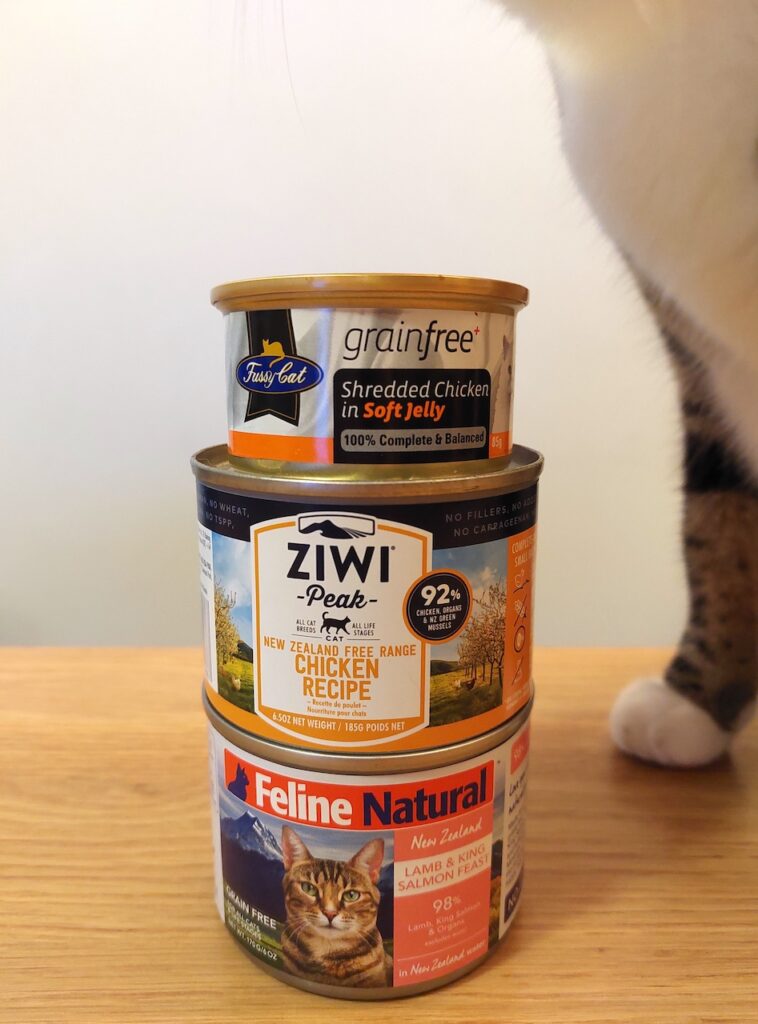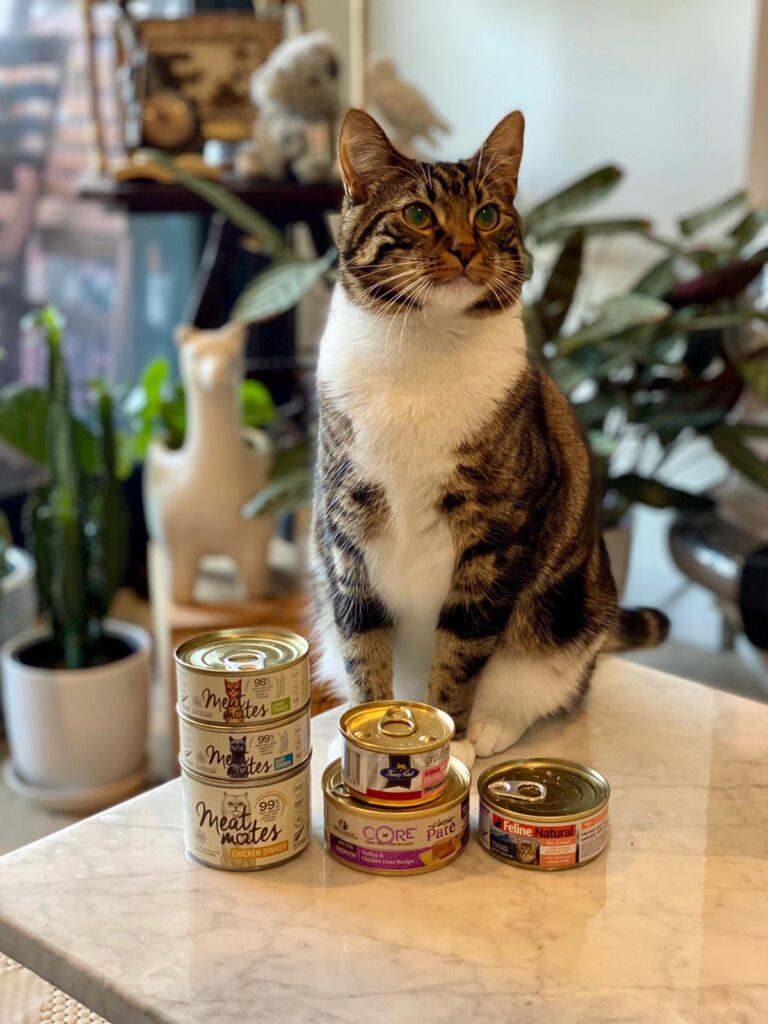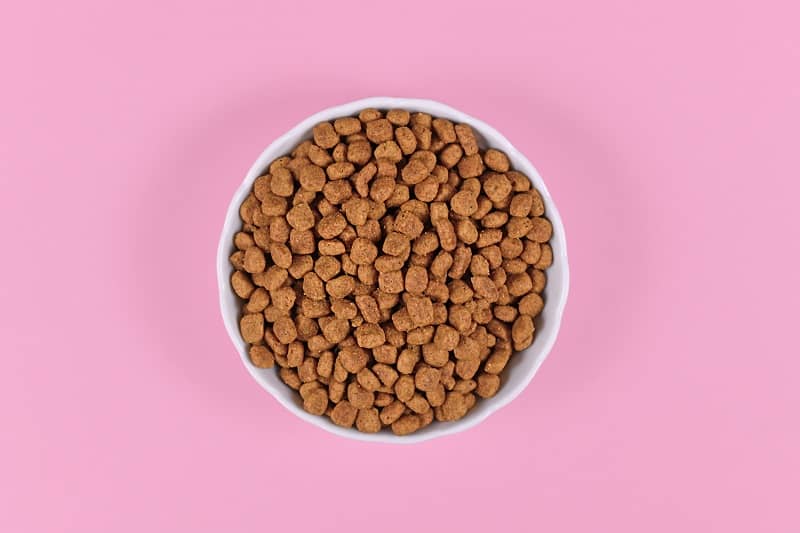Last Updated on July 8, 2023 by Indy the Cat
Welcome to part 2 in our series on rotation diets. If you missed our first article, check out part 1 here for our top 5 reasons to start a rotation diet today. We believe every cat can benefit from such a diet, so let’s take a look at how we can develop your cat’s rotation diet!
1. Transition slowly
The number 1 rule of introducing food is to go slow. Repeat this out loud as its the most common mistake people make.
I will transition my cat slowly when introducing new food.
Any new brand OR flavour of an existing brand should be introduced slowly to a cat. I’ve heard stories of people claiming their cats are fussy and all they do is erratically switch food by plopping it down in front of them. Then they wonder why their cats don’t like it.
Cats are sensitive to food changes and usually become more sensitive as they age. Allow them ample time to adjust to the food by steadily increasing the new food while decreasing the old food over a week or two. The best time to begin a rotation diet is when they are kittens as they are building new routines in life.
Building a schedule
Here’s an example of Indy’s transition schedule when he first started as a kitten.
- Day 1 & 2 – 80% old food / 20% new food
- Day 3 & 4 – 60% old food / 40% new food
- Day 5 & 6 – 40% old food / 60% new food
- Day 7 & 8 – 20% old food / 80% new food
- Day 9 – 100% new food
Note: Most unportioned food can be kept in the fridge for up 3 days in a sealed container. After refrigerating food, we will mix moderately hot/warm water with the food to bring the temperature back up to room temperature.
Tip: Slightly warm food is more appetising to cats as the heat brings out the aromas.
Finishing the transition
You can make alterations to the schedule by increasing the new food quicker if your cat is adjusting faster than expected. However, we would only do so if your cat is accustomed to taking on new food. These days, Indy will transition to a new food over about 5-6 days as he has been exposed to many brands and proteins. After each day, it is important to check that the cat’s stools are still normal before making further increases in new food. See point #4 for further troubleshooting tips.
Once your cat is 100% transitioned to a food, you can safely add it to any meal as part of the rotation. As the rotation grows, it’ll be easier to serve a different food each meal.
2. Start with what works
As you start your rotation diet, you should always start from the cat’s original food. As in, start with what you know works. This may be 1 or 2 different brands or recipes that you know your cat will eat. This is the baseline and starting point for building your rotation diet. It will serve as a familiar stepping stone for acclimatising your cat.
Important: It is important to mix your old and new food together thoroughly, especially during the first few days as the cat is adjusting to the food. This works better with wet food as the cat won’t pick out bits of food. Mixing the flavours will allow them to acclimate more easily.
What if you’re in a situation where you’ve found yourself with a cat and don’t know what they ate in the past? In this unlikely scenario, we would start with food that is rated to be highly palatable by other cat owners. You can mix in things like plain boiled chicken or use one of my secret weapons; pour in some tuna water (canned tuna in water only) to their food and mix it up. It’s hard to find a cat that isn’t enticed by the fishy smell of tuna! After doing this for a meal or two, you can likely stop adding the water. You don’t want to get your cat hooked on tuna or its water!
Unsurprisingly, the next step is to begin selecting new food to add to the rotation diet.

3. Build a diet of variety
Now that we know how to start transitioning your cat to a new diet, we must select new foods that your cat will add to their rotation. There are no set rules for how you build a rotation diet, but it’s important to keep in mind a few things, especially when starting out.
- What proteins and textures has your cat been exposed to?
- Are there ones that he/she tends to prefer over others?
- Has your cat ever reacted badly to a protein or ingredient? (e.g. diarrhea – the most common, vomiting, gagging, other unusual behaviour)
The answers to these questions should give you an indicator of where you might want to start. It may be easier to choose similar textures or proteins depending on how exposed your cat is to different foods. If he/she is a kitten, there is no reason for the cat to be fussy and you should have free rein over the choices. The only thing stopping you may be if your cat reacts negatively to certain ingredients (for example thickeners or perhaps an allergic reaction to a specific protein). Your cat may have preferences for one texture over another, but if you can expose them to as many as possible as a kitten, this may not really matter in the future.
Speaking of allergens, this is another benefit of rotation diets that wasn’t mentioned in the first article. By exposing your cat to various proteins over its lifetime, it is said to decrease the chances of developing allergens to specific proteins. Another win!
What we’re aiming to achieve
The goal while building the diet, especially early on in the cat’s life, is to expose your cat to as many proteins and textures as possible. This will make them more adaptable in the future as we mentioned in our first article. Some proteins and textures to consider are the following:
Texture examples: Pate, Shredded, Cubed, Flaked, Minced, Morsels, Sliced, Stews, Blends, Broths
Protein examples: Chicken, Beef, Lamb, Mackerel, Salmon, Venison, Duck, Rabbit, Goat
By month 7, Indy was across over 6 different wet foods (3 brands) and 1 dry food and could eat any one of them on a given day. At the time of print, he is currently across 10 wet foods as an adult, and 2 dry foods. Now that’s flexibility that any cat parent would love! If you need more ideas, check out some of our reviews for what Indy has tried and what we like.
4. Make adjustments and troubleshoot as you grow the rotation diet
As you introduce new brands and recipes into your cat’s diet, either one of two things will happen. Either it will go well and you can proceed as normal with the transition schedule or you have to stop and re-evaluate. Most commonly, a cat may have diarrhea if the food is not agreeing with them.
How to troubleshoot
If things were going well, but you hit a roadblock during an increase in new food portions, its possible that the amount was too much for your cat and you have to slow down. One option you have is to scale it back to a previous level until they acclimatize. If you need to settle their stomach again, you can also try resetting their diet with only their original food or try some plain foods like boiled chicken meat. As you continue, you can go slower if your cat is particularly sensitive to changes.
If it isn’t the speed of transition that is causing an issue, it is possible certain ingredients (common suspects include thickeners such as gums and additives) in the food can upset a sensitive stomach or cause irritation for other reasons. Another possibility is that, it could be ingredient allergy, most commonly allergies to a specific protein. The article link above discusses other symptoms that could suggest an allergy. You could try similar foods but change the protein and see if it is still an issue with your cat. Single protein wet foods are great for this isolated test. Of course, you can always speak to you vet about potential allergies or problems.
Troubleshooting is definitely the hardest part about developing a diet, especially when certain foods trigger a reaction from your cat. In many cases, following rule #1 with care will allow many cats to transition to a new food with minimal issues.
The end result
Building a rotation diet does take some time and effort, but as you can see, it’s not all that hard. It will require some patience, some possible investigative work and a willingness to give it a go. For those of us who practice it, we are huge fans and believers in its benefits.
We love hearing about success stories and are always happy to help owners navigate their own journey. Feel free to share yours below or drop us a question if something was unclear!
If you spot an error in this article, please do not hesitate to let us know!



Pingback: How to Feed Kittens – 5 Best Feeding Tips for Kitten -